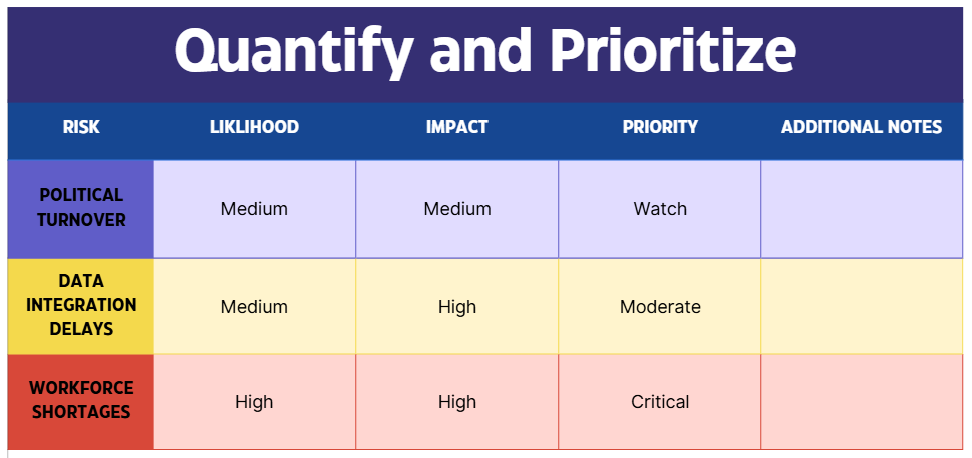Risk Management for Rural Health Transformation: Anticipate, Adapt, and Advance
Even the strongest Rural Health Transformation (RHT) application can stumble without a plan to manage risk. CMS knows this, and so do state reviewers. That’s why a credible risk-mitigation framework is essential, and it’s a sign of readiness.
Rural transformation touches politics, people, and policy. The smartest states anticipate turbulence and show exactly how they’ll stay the course.
This seventh post in the RHT Application Roadmap series explains how to identify common risks, design mitigation strategies, and strengthen confidence in your state’s ability to deliver results.
Step 1: Name the Risks Early
The first rule of risk management: don’t hide the hard parts. Acknowledging challenges builds credibility. CMS reviewers expect to see realism, not optimism.
Common RHT-era risks include:
Political change: shifts in administration or legislative priorities.
Workforce shortages: turnover among nurses, aides, and direct-care staff.
Funding instability: delayed appropriations or loss of matching funds.
Data limitations: fragmented or outdated rural health information.
Stakeholder fatigue: over-consultation without visible progress.
Operational complexity: multiple agencies or vendors working on tight deadlines.
Tip: Present these risks in categories—political, financial, operational, and social—so mitigation strategies align logically.
Step 2: Quantify and Prioritize
Not all risks are equal. Assign each a likelihood (Low/Medium/High) and potential impact (Low/Medium/High). Focus mitigation on those that rank High × High.
Example:
This quick matrix signals to CMS that the state has a disciplined, data-driven approach to risk oversight.
Step 3: Create Targeted Mitigation Strategies
For each high-priority risk, outline both prevention and contingency actions.
Examples:
Political Change:
Build bipartisan legislative briefings to keep transformation goals visible.
Document statutory authority early to insulate programs from leadership turnover.
Workforce Shortages:
Partner with community colleges on accelerated training pipelines.
Offer retention incentives and mentorship programs for existing staff.
Funding Instability:
Blend federal RHT dollars with state matching and private grants.
Establish reserve funds for continuity if reimbursements lag.
Data and Technology Challenges:
Invest early in interoperable systems.
Secure MOUs for data sharing among agencies.
Stakeholder Fatigue:
Rotate meeting formats and highlight visible wins.
Communicate progress in plain language—monthly “transformation updates.”
Each mitigation plan should name a responsible owner and a timeline for review.
Step 4: Establish a Rural Health Risk Register
CMS reviewers respond well to evidence of structure. A Risk Register is a simple, living document that tracks evolving threats and responses.
Include:
Risk description and category
Likelihood and impact score
Mitigation steps and responsible party
Status (open, mitigated, closed)
Review date and next actions
Updating this register quarterly demonstrates active governance and continuous improvement.
Step 5: Build Flexibility Into Implementation
Rigid plans break under pressure. Sustainable ones bend. Embed flexibility by:
Setting phased implementation milestones (so adjustments can be made without derailing progress).
Allowing budget reallocations within defined parameters.
Using pilot programs before statewide scale-up.
Maintaining pre-approved contingency vendors for technology or staffing.
This shows CMS that your state is prepared to adapt while maintaining accountability.
Step 6: Communicate Transparently
Risk management fails when communication falters. Adopt a “no surprises” culture across agencies and partners:
Establish clear escalation protocols.
Provide regular briefings to leadership and CMS regional offices.
Share public-facing updates so communities understand progress and challenges.
Transparency builds trust—and turns potential criticism into collaboration.
Step 7: Leverage Risk as a Leadership Tool
The most advanced states don’t just manage risk; they use it to drive innovation. Each identified risk is also a diagnostic signal—showing where systems are weakest and where transformation can have the greatest impact.
By tracking risk patterns, states can:
Target technical assistance where it’s most needed.
Justify new investments in data, workforce, or governance capacity.
Demonstrate to CMS that they learn, adapt, and evolve.
The Bottom Line
A credible RHT application doesn’t promise perfection; it promises preparedness. Risk management proves a state understands its ecosystem, anticipates barriers, and has realistic plans to overcome them.
By naming risks honestly, quantifying them thoughtfully, and mitigating them systematically, your state demonstrates not just readiness—but resilience.
Call to Action
State RHT Teams: Develop your first risk register and review it at every steering meeting.
Agency Leaders: Assign clear accountability for top-tier risks—don’t let them drift.
Providers and Partners: Flag on-the-ground challenges early; they’re part of the state’s learning loop.
The ability to adapt under pressure is what separates temporary programs from lasting transformation. Anticipate. Adapt. Advance.
